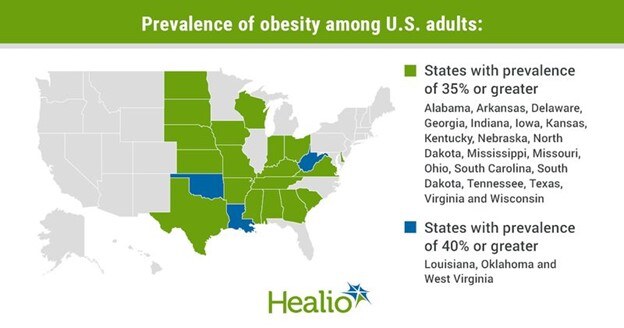Key takeaways:
- All states had an adult obesity prevalence exceeding 20%.
- Obesity prevalence differed based on race and ethnicity, and it was particularly high among Black adults.
According to CDC data, 22 states had an adult obesity prevalence of 35% or higher in 2022, up from 19 in 2021 and none in 2012.
“Our updated maps send a clear message that additional support for obesity prevention and treatment is an urgent priority,” Karen Hacker, MD, MPH, director of the CDC’s National Center for Chronic Disease Prevention and Health Promotion, said in a press release.
According to the CDC, the data underscore the need for population-based interventions and evidence-based health care services, like medications and surgery.
The 22 states with an adult obesity prevalence of 35% or higher include Alabama, Arkansas, Delaware, Georgia, Indiana, Iowa, Kansas, Kentucky, Louisiana, Mississippi, Missouri, Nebraska, North Dakota, Ohio, Oklahoma, South Carolina, South Dakota, Tennessee, Texas, Virginia, West Virginia, and Wisconsin.
Of those states, Louisiana, Oklahoma and West Virginia had a prevalence of 40% or greater. All states and territories had a prevalence higher than 20% — meaning, more than one in five adults have obesity.
The prevalence of obesity also varied heavily by race and ethnicity. The CDC found that among geographic groups with enough data — which included states, territories and Washington, D.C. — that had an adult obesity prevalence at or above 35% was:
- 38 (out of 48 states and Washington, D.C.) for Black adults;
- 33 (out of 47 states) for non-Hispanic American Indian or Alaska Native adults;
- 32 (out of 49 states, two territories and Washington, D.C.) for Hispanic adults;
- 14 (out of 49 states, one territory and Washington, D.C.) for non-Hispanic white adults; and
- zero (out of 37 states, one territory and Washington, D.C.) for non-Hispanic Asian adults.
Additionally, adults aged 45 to 54 years had the highest obesity prevalence among all age groups (39.9%), whereas adults aged 18 to 24 years had the lowest (20.5%).
Hacker explained that because obesity is caused by several factors like physical activity levels, dietary patterns, certain medications and genetics, “there is no one size fits all approach” to addressing the problem.
“However, we know the key strategies that work include addressing the underlying social determinants of health such as access to health care, healthy and affordable food, and safe places for physical activity,” she said.
References:
- Adult obesity prevalence remains high; support for prevention and treatment needed. https://www.cdc.gov/media/releases/2023/p0922-adult-obesity.html. Published Sept. 21, 2023. Accessed Sept. 29, 2023.
- CDC. Adult obesity prevalence maps. https://www.cdc.gov/obesity/data/prevalence-maps.html. Updated Sept. 21, 2023. Accessed Sept. 29, 2023.



